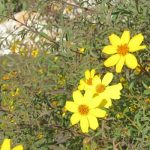Autumn is upon us and so is the fall planting season. Check out our top 10 list of native plants to sow this season.
It’s tradition in South Texas on Sept. 16 to reenact the Grito de Dolores , Father Miguel Hidalgo’s cry for independence from Spain.
Here’s our grito — our cry for freedom from watering unnecessarily. This is our shout out for the top 10 native plants of Texas and Mexico. Grab one or grab them all, either way your landscape will be better for it.
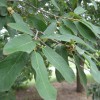 Monterrey oak (Quercus polymorpha), aka Mexican white oak, is a semi-evergreen oak that grows in the mountains near Monterrey and Saltillo and in Val Verde county. It’s considered to be one of the fastest growing oaks in our area and as a white oak is oak wilt resistant.
Monterrey oak (Quercus polymorpha), aka Mexican white oak, is a semi-evergreen oak that grows in the mountains near Monterrey and Saltillo and in Val Verde county. It’s considered to be one of the fastest growing oaks in our area and as a white oak is oak wilt resistant.
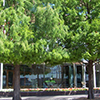 Montezuma cypress (Cupressus mucronatum) is native to Mexico and along the Rio Grande valley. It’s more drought tolerant than the bald cypress, but faster growing. One of the largest trees in the world, the Árbol del Tule, is a Montezuma cypress.
Montezuma cypress (Cupressus mucronatum) is native to Mexico and along the Rio Grande valley. It’s more drought tolerant than the bald cypress, but faster growing. One of the largest trees in the world, the Árbol del Tule, is a Montezuma cypress.
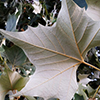 Mexican sycamore (Platanus mexicana) is known for its fast growth and white fuzz beneath the leaves, which prevents sucking insects from causing havoc in the summertime. Early fall is the best time to search the nurseries for this tree.
Mexican sycamore (Platanus mexicana) is known for its fast growth and white fuzz beneath the leaves, which prevents sucking insects from causing havoc in the summertime. Early fall is the best time to search the nurseries for this tree.
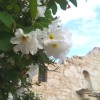 Wild olive (Cordia boissieri ), aka Mexican olive, ranges from Nueces County to Northern Mexico. Not a real olive, it does produce a similar fruit that is palatable by a host of birds and mammals. A real star during the summer with its white flowers, wild olive will freeze back occasionally in San Antonio and will not grow in the Hill Country.
Wild olive (Cordia boissieri ), aka Mexican olive, ranges from Nueces County to Northern Mexico. Not a real olive, it does produce a similar fruit that is palatable by a host of birds and mammals. A real star during the summer with its white flowers, wild olive will freeze back occasionally in San Antonio and will not grow in the Hill Country.
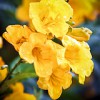 Esperanza (Tecoma stans ) is native to West Texas and Northern Mexico, but is well known in San Antonio as a fast growing, bright yellow-flowered shrub. The preferred variety is ‘Gold Star’ esperanza, which may be grown in pots or in the ground. Always cut back to 3 inches by the first week of March or you’ll have large dead stems for the rest of the year.
Esperanza (Tecoma stans ) is native to West Texas and Northern Mexico, but is well known in San Antonio as a fast growing, bright yellow-flowered shrub. The preferred variety is ‘Gold Star’ esperanza, which may be grown in pots or in the ground. Always cut back to 3 inches by the first week of March or you’ll have large dead stems for the rest of the year.
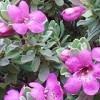 Cenizo (Leucophyllum frutescens) is the ubiquitous shrub of South Texas and Northern Mexico. Its purple flowers signal (or are the result of) rain. The debate is continuous and vigorous. There are four species and varieties to choose from and all are fantastic: common, ‘Green Cloud’, fragrant and ‘Lynn Lowery Legacy’.
Cenizo (Leucophyllum frutescens) is the ubiquitous shrub of South Texas and Northern Mexico. Its purple flowers signal (or are the result of) rain. The debate is continuous and vigorous. There are four species and varieties to choose from and all are fantastic: common, ‘Green Cloud’, fragrant and ‘Lynn Lowery Legacy’.
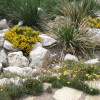 Four nerve daisy (Tetraneuris scaposa), aka hymenoxys, is a durable yellow flower perennial. It prefers rocky well drained soil, but will tolerant other sites. Also, it attracts butterflies and is deer resistant.
Four nerve daisy (Tetraneuris scaposa), aka hymenoxys, is a durable yellow flower perennial. It prefers rocky well drained soil, but will tolerant other sites. Also, it attracts butterflies and is deer resistant.
 Gregg’s mistflower (Conoclinium greggii ) is a butterfly magnet. Any butterfly garden worth its weight in gold nectar must have one of the four available options: Gregg’s, blue, white and fragrant.
Gregg’s mistflower (Conoclinium greggii ) is a butterfly magnet. Any butterfly garden worth its weight in gold nectar must have one of the four available options: Gregg’s, blue, white and fragrant.
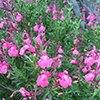 Gregg’s salvia (Salvia greggii), aka autumn sage, is the most common Salvia species sold in San Antonio. It’s appreciated by humans, butterflies and hummingbirds alike. Gregg’s salvia comes in white, pink, red, cherry, raspberry, purple and two-toned flowers. Gregg’s salvia prefers full sun, but will tolerate a little shade.
Gregg’s salvia (Salvia greggii), aka autumn sage, is the most common Salvia species sold in San Antonio. It’s appreciated by humans, butterflies and hummingbirds alike. Gregg’s salvia comes in white, pink, red, cherry, raspberry, purple and two-toned flowers. Gregg’s salvia prefers full sun, but will tolerate a little shade.
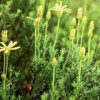 Damianita (Chrysactinia mexicana ) is perhaps the toughest plant for us in San Antonio. It will literally grow in the cracks of asphalt parking lots. The only way humans can kill it is by providing it tender loving care. Damianita is evergreen, deer resistant and its yellow flowers attract butterflies and hummingbirds.
Damianita (Chrysactinia mexicana ) is perhaps the toughest plant for us in San Antonio. It will literally grow in the cracks of asphalt parking lots. The only way humans can kill it is by providing it tender loving care. Damianita is evergreen, deer resistant and its yellow flowers attract butterflies and hummingbirds.
Consider this your “shout out” to begin your fall planting. By the way, did I mention that wild olive, esperanza, cenizo, mistflower, Salvia and damianita are all included in theWaterSaver Landscape coupon ? They are so no excuses. Get your coupons and get planting.



